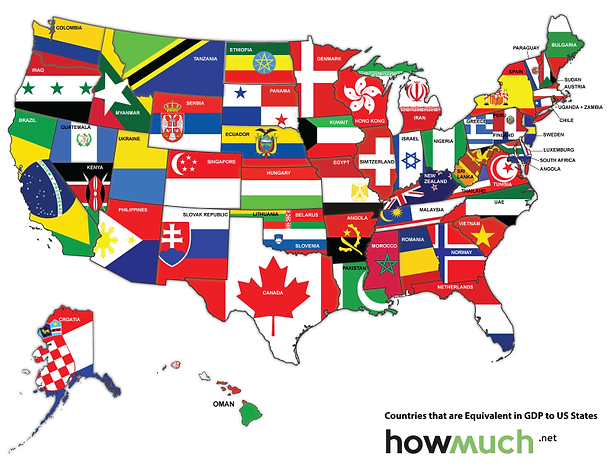State GDPs Compared To Countries
We often talk about the US GDP and the GDPs of other major world economies and their overall implications. Today I thought it would be fund to share a really interesting article/map I ran into on LinkedIn.

The United States' annual GDP is massive compared to virtually every other country in the world...and it makes sense if you think of the United States not as one country, but look at each US state as though it were its own country with its own distinct GDP. The point here is that the US could be more a continent like Europe with a bunch of separate GDPs because it is so huge.
An analyst at CEVA Logistics illustrated this using the national GDP data from the International Monetary Fund (IMF) and state data from the Bureau of Economic Analysis (BEA) to put together a map that displays a country of comparable size (in terms of GDP) for each state. FYI, all of the countries shown have 2014 GDPs that are roughly equivalent (+/- 10%) to the GDP of the state on which it is shown - in other words, these numbers are approximate, not exact.
The two largest economies in the US, California and Texas, are equivalent to the 8th and 10th largest economies in the world, respectively. California's GDP is on par with that of Brazil, while Texas is close to Canada. As we noted a few weeks back in the piece on the world's largest economies, Brazil and Canada are the 8th and 10th largest economies in the world, respectively.
There are some more pretty interesting observations: states like New York, Florida, Illinois, and New Jersey produce roughly the same wealth as some very rich countries – Spain, Netherlands, Switzerland, and Sweden, respectively. In fact, the GDP of New York state is on par with Spain’s despite the fact that Spain has more than twice as many people. This can also be seen with a state like Ohio, whose population is about 11.6 million and it possesses a GDP roughly the size of Nigeria, which has a population of 173.6 million.
However, the relationship between country and state GDPs may actually end up shifting over time, but this overall phenomenon isn't expected to disappear in the near future. The IMF also predicted that the US GDP will increase by roughly $5.1 trillion by 2020 to a total of $22.5 trillion. Even though China is expected to grow its economy by $5.8 trillion by 2020, the US will still dominate the rest of the world in terms of economic size. Other than China, there is no economy contending with the size of America...at least for the time being.

Disclosure: None.
Disclaimer:
All data and information provided on this site is strictly the author’s opinion and does not constitute any financial, legal or other type ...
more


